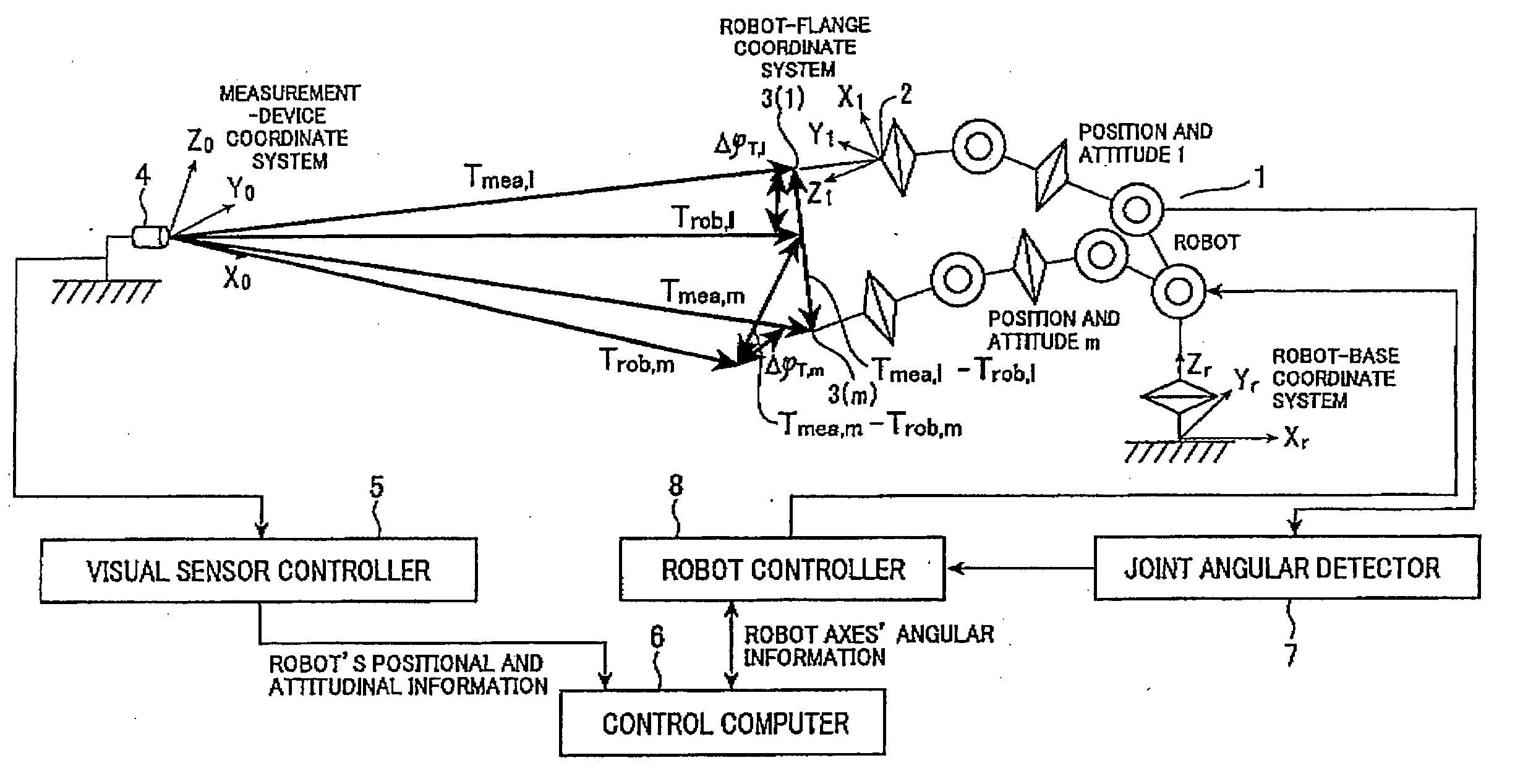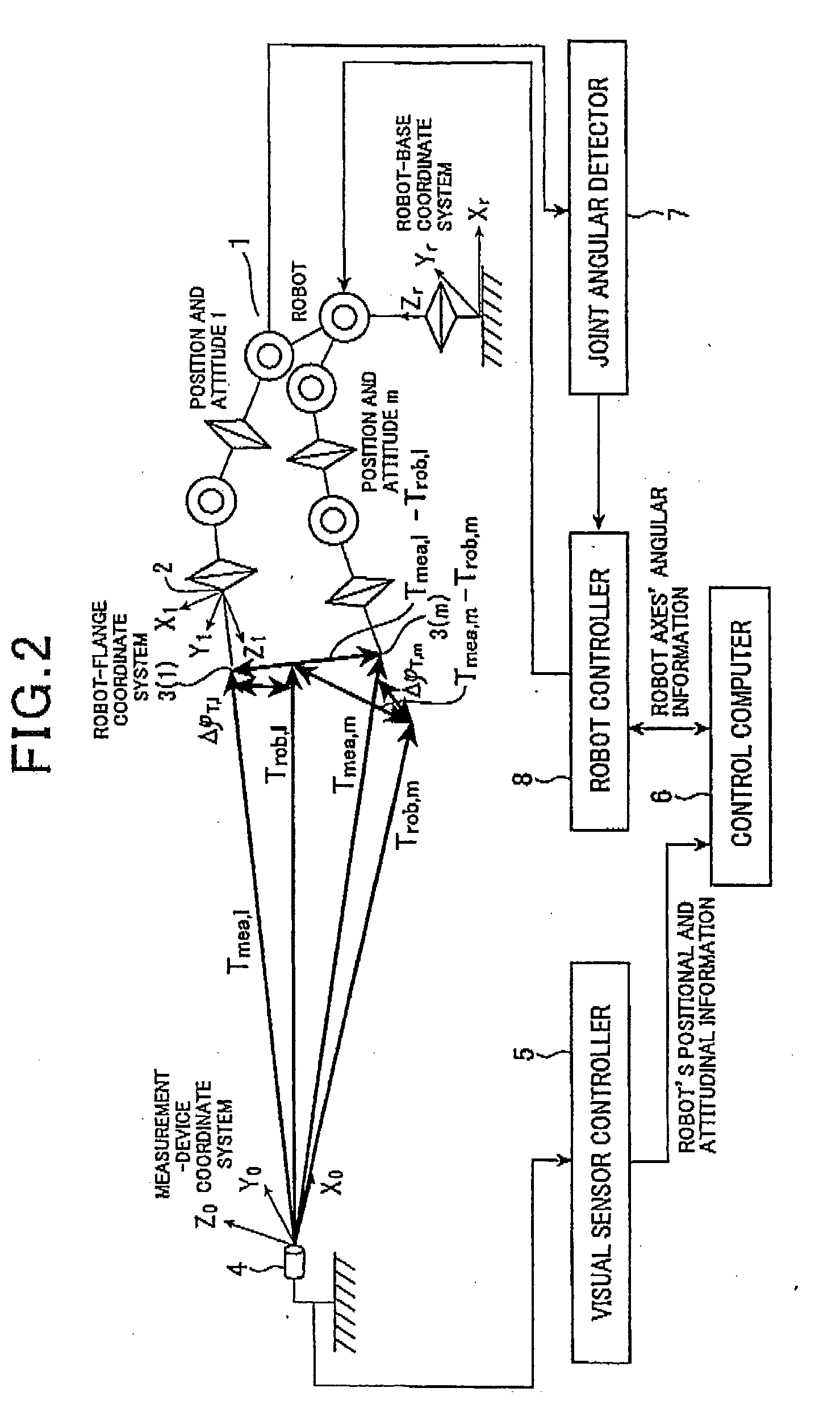Method and apparatus for calibrating position and attitude of arm tip of robot
a robot arm and arm tip technology, applied in the field of methods and apparatus for calibrating the position and attitude can solve the problems of inconvenient calibration techniques, low accuracy of calibration, and difficulty in measuring the absolute position of the arm tip of the robot, etc., and achieve the effect of higher accuracy
- Summary
- Abstract
- Description
- Claims
- Application Information
AI Technical Summary
Benefits of technology
Problems solved by technology
Method used
Image
Examples
first embodiment
[0043]Referring to FIGS. 2 and 3, a first embodiment of the calibration apparatus according to the present invention will now be described.
[0044]The configuration of a robot system shown in FIG. 2 is the same as that shown in FIG. 1 except for a technique for calibration which is performed by the control computer 6. Hence, the same components in FIG. 2 are given the same reference numerals as those shown in FIG. 1 for a simplified description.
[0045]Practically, in the configuration in FIG. 1, the arm tip of the robot 1, which is the tip of the tool 3, is calibrated for its one position and attitude by calculating an error between a measured result of the measurement device 4 and a control result of the control computer 6. By contrast, in the present embodiment, the arm tip of the robot 1 is calibrated in tow control modes in which the arm tip is controlled at a position and attitude (position / attitude) “1” and a position and attitude (position / attitude) “m”. In each control mode, th...
second embodiment
[0068]Referring to FIG. 4, a second embodiment of the calibration apparatus according to the present invention will now be described.
[0069]The second embodiment and subsequent embodiment adopt the same hardware configuration of the robot system as that described in FIG. 2. Hence, the components which are the same as those in the first embodiment are given the same reference numerals for a simplified description.
[0070]While the reference position and attitude m in the first embodiment is given only one point, the reference position and attitude m is given a plurality of points (=1 to l) for the calibration in the second embodiment. In this case, as for the error matrix Δq, the formula (12) is replaced by a formula (21), which is as follows:
Δq=([Jq,1(θ,q)-Jq,m1(θ,q)⋮Jq,n(θ,q)-Jq,m1(θ,q)Jq,1(θ,q)-Jq,m2(θ,q)⋮Jq,n(θ,q)-Jq,m2(θ,q)Jq,1(θ,q)-Jq,m2(θ,q)⋮Jq,n(θ,q)-Jq,m1(θ,q)]t[Jq,1(θ,q)-Jq,m1(θ,q)⋮Jq,n(θ,q)-Jq,m1(θ,q)Jq,1(θ,q)-Jq,m2(θ,q)⋮Jq,n(θ,q)-Jq,m2(θ,q)Jq,1(θ,q)-Jq,m2(θ,q)⋮Jq,n(θ,q)-Jq,m...
third embodiment
[0074]Referring to FIG. 5, a third embodiment of the present invention will now be described.
[0075]The calibration apparatus according to the third embodiment improvise that according to the first embodiment in selecting the positions and attitudes in the arm's movable space.
[0076]In this respect, the first embodiment has been described on condition that, at step S2 in FIG. 3, the positions and attitudes for calibration are selected properly, with almost no bias of selected position within the arm's movable space. This means that the stimulated inverse matrix of a Jacobian determinant can be obtained reliably.
[0077]However, although it is rare, it may happen that the positions and attitudes are selected from only a specific part of the movable space or are erroneously selected partly or entirely from the same positions. In such cases, the stimulated inverse matrix of a Jacobian determinant may not be obtained. Such an undesired situation is covered by the third embodiment.
[0078]If t...
PUM
 Login to View More
Login to View More Abstract
Description
Claims
Application Information
 Login to View More
Login to View More - R&D
- Intellectual Property
- Life Sciences
- Materials
- Tech Scout
- Unparalleled Data Quality
- Higher Quality Content
- 60% Fewer Hallucinations
Browse by: Latest US Patents, China's latest patents, Technical Efficacy Thesaurus, Application Domain, Technology Topic, Popular Technical Reports.
© 2025 PatSnap. All rights reserved.Legal|Privacy policy|Modern Slavery Act Transparency Statement|Sitemap|About US| Contact US: help@patsnap.com



